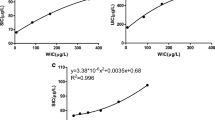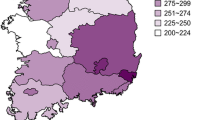Abstract
China has issued the “Reform Plan of the Salt Industry System” in 2016 and it is necessary to attach the importance to the changes of iodine nutritional status of those people who might consume non-iodized salt for a long time. Forty-six elderly subjects were recruited and replaced iodized salt with non-iodized salt for 6 months. Urine iodine concentration (UIC), dietary iodine intake, thyroid function, thyroid B-ultrasound, and plasma iodine were monitored during the follow-up period. The median dietary iodine intakes of the baseline, the 1st, 2nd,3rd, 4th, and 6th month were 255.3 µg/d, 183.6 µg/d, 164.6 µg/d, 179.2 µg/d, 139.4 µg/d, and 146.9 µg/d, respectively. The median UIC of baseline and follow-up was 155.7 (111.0–263.1) µg/L and 69.7(36.7–119.8) µg/L, respectively. The proportion of urinary iodine less than 50 g/L at the baseline and follow-up was 3.0 (0 ~ 8.9)% and 36.0 (33.1 ~ 38.9)%, respectively. Dietary iodine intake had a significant correlation with urine iodine. Six subjects (15.4%) had abnormal thyroid function. Three subjects (7.7%) had first-onset new nodules or enlarged solid nodules and the median UIC of these three subjects during the follow-up period was 39.8 µg/L, which was significantly lower than that of other subject (74.0 µg/L). T4 and T3 had a significant correlation with plasma iodine. The importance of monitoring and evaluating iodine nutrition of people consuming non-iodized salt should be stressed to prevent the potential poor iodine nutrition and iodine deficiency diseases.





Similar content being viewed by others
Data Availability
The datasets generated during and/or analyzed during the current study are not publicly available due to the total project being not over yet but are available from the corresponding author on reasonable request.
References
Zimmermann MB, Jooste PL, Pandav CS (2008) Iodine-deficiency disorders. Lancet 372(9645):1251–1262. https://doi.org/10.1016/S0140-6736(08)61005-3
Farebrother J, Zimmermann MB, Andersson M (2019) Excess iodine intake: sources, assessment, and effects on thyroid function. Ann N Y Acad Sci 1446(1):44–65. https://doi.org/10.1111/nyas.14041
Hutchings N, Aghajanova E, Baghdasaryan S, Qefoyan M, Sullivan C, He X, Manoukian M, van der Haar F, Gerasimov G, Braverman L, Bilezikian JP (2019) A stratified cross-sectional cluster model survey of iodine nutrition in Armenia after a decade of universal salt iodization. Endocr Pract 25(10):987–993. https://doi.org/10.4158/EP-2018-0634
Codling K, Quang NV, Phong L, do Phuong H, Quang ND, Bégin F, Mathisen R (2015) The rise and fall of universal salt iodization in vietnam: lessons learned for designing sustainable food fortification programs with a public health impact. Food Nutr Bull 36(4):441–454. https://doi.org/10.1177/0379572115616039
Rah JH, Anas AM, Chakrabarty A, Sankar R, Pandav CS, Aguayo VM (2015) Towards universal salt iodisation in India: achievements, challenges and future actions. Matern Child Nutr 11(4):483–496. https://doi.org/10.1111/mcn.12044
Doggui R, El Ati-Hellal M, Traissac P, Lahmar L, El Ati J (2016) Adequacy assessment of a universal salt iodization program two decades after its implementation: a national cross-sectional study of iodine status among school-age children in tunisia. Nutrients 9(1):6. https://doi.org/10.3390/nu9010006
Jayatissa R, Gorstein J, Okosieme OE, Lazarus JH, Premawardhana LD (2020) Stable iodine nutrition during two decades of continuous universal salt iodisation in Sri Lanka. Nutrients 12(4):1109. https://doi.org/10.3390/nu12041109
Zhao W, Han C, Shi X, Xiong C, Sun J, Shan Z, Teng W (2014) Prevalence of goiter and thyroid nodules before and after implementation of the universal salt iodization program in mainland China from 1985 to 2014: a systematic review and meta- analysis. PLoS ONE 9(10):e109549. https://doi.org/10.1371/journal.pone.0109549
Wang Y, Zhang Z, Ge P, Wang Y, Wang S (2009) Iodine status and thyroid function of pregnant, lactating women and infants (0–1yr) residing in areas with an effective universal salt iodization program. Asia Pac J Clin Nutr 18(1):34–40
Meng F, Zhao R, Liu P, Liu L, Liu S (2013) Assessment of iodine status in children, adults, pregnant women and lactating women in iodine-replete areas of China. PLoS ONE 8(11):e81294. https://doi.org/10.1371/journal.pone.0081294
National Standard of the People’s Republic of China .GB 26878–2011. Iodine content of edible salt. Ministry of Health of the People’s Republic of China, 2011.
Xinhuanet. http://www.xinhuanet.com/politics/2016-05/05/c_1118811617.htm. Accessed 8 July 2021
National Health Commission of the People’s Republic of China. http://www.nhc.gov.cn/cms-search/xxgk/getManuscriptXxgk.htm?id=51576. Accessed 8 July 2021
Liu P, Fan L, Meng F, Xiaohui S, Liu S, Shen H, Sun D (2020) Recollection: prevention and control of iodine deficiency disorders-China, 1995–2020. China CDC Weekly 2(20):345–349. https://doi.org/10.46234/ccdcw2020.090
Hao S, Min G, Wenxing G, Qi Z, Yanbo B, Gao Shu Wu, Wen ZW (2019) Investigation and analysis of salt sales and public consumption in supermarkets in Tianjin after salt reform. J Hyg Res 48(6):932–937 (Chinese)
National Standard of the People’s Republic of China . GB5009.267–2016(2016) Determination of iodine in food. National Health and Family Planning Commission of the People’s Republic of China, State Food and Drug Administration.
Health Industry Standard of the People’s Republic of China, WS/T 107.2–2016(2016) Determination of iodine in urine-part 2: inductively coupled plasma mass spectrometry method. National Health Commission of the People’s Republic of China.
Vought RL, London WT (1967) Iodine intake, excretion and thyroidal accumulation in healthy subjects. J Clin Endocrinol Metab 27(7):913–919. https://doi.org/10.1210/jcem-27-7-913
WHO/ICCIDD/UNICEF (2007) Assessment of iodine deficiency disorders and monitoring their elimination: a guide for programme managers, 3rd edn. WHO Press, Geneva
Unicef(2018) Guidance on the monitoring of salt iodization programmes and determination of population iodine status.
Delange F (1997) Neonatal screening for congenital hypothyroidism: results and perspectives. Horm Res 48(2):51–61. https://doi.org/10.1159/000185485
Zimmermann MB, Aeberli I, Torresani T, Burgi H (2005) Increasing the iodine concentration in the Swiss iodized salt program markedly improved iodine status in pregnant women and children: a 5-y prospective national study. Am J Clin Nutr 82(2):388–392. https://doi.org/10.1093/ajcn.82.2.388
Zimmermann MB (2009) Iodine deficiency. Endocr Rev 30(4):376–408. https://doi.org/10.1210/er.2009-0011
Quest Diagnostics. https://testdirectory.questdiagnostics.com/test/test-detail/16599/iodine-serumplasma?p=r&q=Iodine,/20Serum/2FPlasma&cc=MASTER. Accessed 21 June 2021
Mayocliniclabs. https://www.mayocliniclabs.com/test-catalog/Clinical+and+Interpretive/81574. Accessed 21 June 2021
Yu S, Wang D, Cheng X, Zhang Q, Wang M, Guo H, Yu B, Zhang X, Xia L, Sun D, Cheng Q, Li P, Yin Y, Ma C, Hou L, Zou Y, Li H, Li D, Qiu L, Ichihara K (2020) Establishing reference intervals for urine and serum iodine levels: a nationwide multicenter study of a euthyroid Chinese population. Clin Chim Acta 502:34–40. https://doi.org/10.1016/j.cca.2019.11.038
Pan Z, Cui T, Chen W, Gao S, Pearce EN, Wang W, Chen Y, Guo W, Tan L, Shen J, Zhang W (2019) Serum iodine concentration in pregnant women and its association with urinary iodine concentration and thyroid function. Clin Endocrinol (Oxf) 90(5):711–718. https://doi.org/10.1111/cen.13945
Cui T, Wang W, Chen W, Pan Z, Gao S, Tan L, Pearce EN, Zimmermann MB, Shen J, Zhang W (2019) Serum iodine is correlated with iodine intake and thyroid function in school-age children from a sufficient-to-excessive iodine intake area. J Nutr 149(6):1012–1018. https://doi.org/10.1093/jn/nxy325
Acknowledgements
We would like to thank Yida Elderly Service Center in Beichen District, Tianjin, for assisting in organizing research subjects.
Funding
The research is supported by a grant from the MAJOR PUBLIC HEALTH PROJECT “Survey and Evaluation of Iodine Nutrition and Thyroid Diseases of Chinese Population,” grant number 131031107000160007.
Author information
Authors and Affiliations
Contributions
Conceptualization, Min Li and Lichen Yang; methodology and formal analysis, Min Li and Lichen Yang; investigation, Min Li, Rui Wang, Jiaxi Lu, Weidong Li, Yichun Hu, and Jing Chen; sample determination, Jiaxi Lu and Wei Ma; writing—original draft preparation, Min Li; writing—review and editing, Min Li and Lichen Yang; supervision, Lichen Yang. All authors have read and agreed to the published version of the manuscript.
Corresponding author
Ethics declarations
Ethics Approval
The study was approved by the Ethical Committee of the Institute for Nutrition and Health, Chinese Center for Disease Control and Prevention (No. 2019–012).
Competing Interests
The authors declare no competing interests.
Additional information
Publisher’s Note
Springer Nature remains neutral with regard to jurisdictional claims in published maps and institutional affiliations.
Rights and permissions
About this article
Cite this article
Li, M., Wang, R., Lu, J. et al. Changes of Iodine Nutritional Status in the Elderly after Replacing Iodized Salt with Non-Iodized Salt for Half a Year. Biol Trace Elem Res 201, 1019–1025 (2023). https://doi.org/10.1007/s12011-022-03216-4
Received:
Accepted:
Published:
Issue Date:
DOI: https://doi.org/10.1007/s12011-022-03216-4




